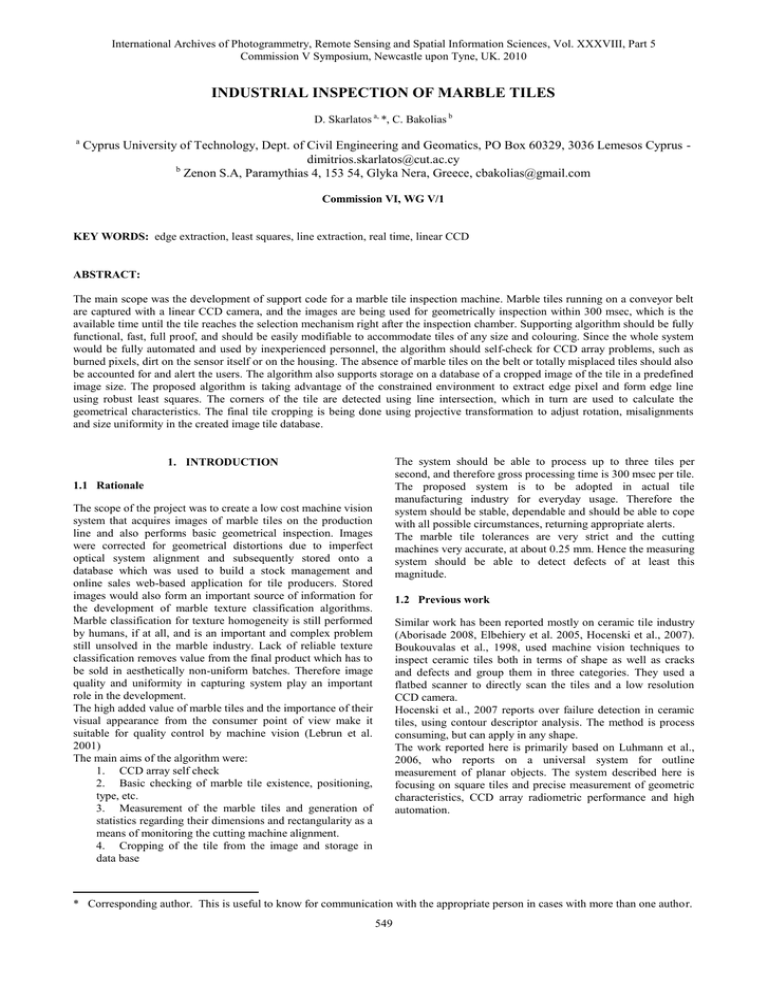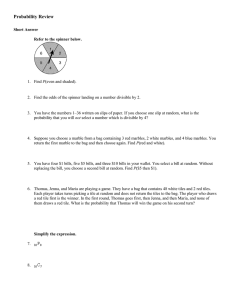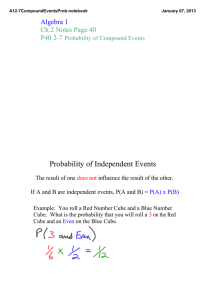International Archives of Photogrammetry, Remote Sensing and Spatial Information Sciences,...
advertisement

International Archives of Photogrammetry, Remote Sensing and Spatial Information Sciences, Vol. XXXVIII, Part 5 Commission V Symposium, Newcastle upon Tyne, UK. 2010 INDUSTRIAL INSPECTION OF MARBLE TILES D. Skarlatos a, *, C. Bakolias b a Cyprus University of Technology, Dept. of Civil Engineering and Geomatics, PO Box 60329, 3036 Lemesos Cyprus dimitrios.skarlatos@cut.ac.cy b Zenon S.A, Paramythias 4, 153 54, Glyka Nera, Greece, cbakolias@gmail.com Commission VI, WG V/1 KEY WORDS: edge extraction, least squares, line extraction, real time, linear CCD ABSTRACT: The main scope was the development of support code for a marble tile inspection machine. Marble tiles running on a conveyor belt are captured with a linear CCD camera, and the images are being used for geometrically inspection within 300 msec, which is the available time until the tile reaches the selection mechanism right after the inspection chamber. Supporting algorithm should be fully functional, fast, full proof, and should be easily modifiable to accommodate tiles of any size and colouring. Since the whole system would be fully automated and used by inexperienced personnel, the algorithm should self-check for CCD array problems, such as burned pixels, dirt on the sensor itself or on the housing. The absence of marble tiles on the belt or totally misplaced tiles should also be accounted for and alert the users. The algorithm also supports storage on a database of a cropped image of the tile in a predefined image size. The proposed algorithm is taking advantage of the constrained environment to extract edge pixel and form edge line using robust least squares. The corners of the tile are detected using line intersection, which in turn are used to calculate the geometrical characteristics. The final tile cropping is being done using projective transformation to adjust rotation, misalignments and size uniformity in the created image tile database. The system should be able to process up to three tiles per second, and therefore gross processing time is 300 msec per tile. The proposed system is to be adopted in actual tile manufacturing industry for everyday usage. Therefore the system should be stable, dependable and should be able to cope with all possible circumstances, returning appropriate alerts. The marble tile tolerances are very strict and the cutting machines very accurate, at about 0.25 mm. Hence the measuring system should be able to detect defects of at least this magnitude. 1. INTRODUCTION 1.1 Rationale The scope of the project was to create a low cost machine vision system that acquires images of marble tiles on the production line and also performs basic geometrical inspection. Images were corrected for geometrical distortions due to imperfect optical system alignment and subsequently stored onto a database which was used to build a stock management and online sales web-based application for tile producers. Stored images would also form an important source of information for the development of marble texture classification algorithms. Marble classification for texture homogeneity is still performed by humans, if at all, and is an important and complex problem still unsolved in the marble industry. Lack of reliable texture classification removes value from the final product which has to be sold in aesthetically non-uniform batches. Therefore image quality and uniformity in capturing system play an important role in the development. The high added value of marble tiles and the importance of their visual appearance from the consumer point of view make it suitable for quality control by machine vision (Lebrun et al. 2001) The main aims of the algorithm were: 1. CCD array self check 2. Basic checking of marble tile existence, positioning, type, etc. 3. Measurement of the marble tiles and generation of statistics regarding their dimensions and rectangularity as a means of monitoring the cutting machine alignment. 4. Cropping of the tile from the image and storage in data base 1.2 Previous work Similar work has been reported mostly on ceramic tile industry (Aborisade 2008, Elbehiery et al. 2005, Hocenski et al., 2007). Boukouvalas et al., 1998, used machine vision techniques to inspect ceramic tiles both in terms of shape as well as cracks and defects and group them in three categories. They used a flatbed scanner to directly scan the tiles and a low resolution CCD camera. Hocenski et al., 2007 reports over failure detection in ceramic tiles, using contour descriptor analysis. The method is process consuming, but can apply in any shape. The work reported here is primarily based on Luhmann et al., 2006, who reports on a universal system for outline measurement of planar objects. The system described here is focusing on square tiles and precise measurement of geometric characteristics, CCD array radiometric performance and high automation. * Corresponding author. This is useful to know for communication with the appropriate person in cases with more than one author. 549 International Archives of Photogrammetry, Remote Sensing and Spatial Information Sciences, Vol. XXXVIII, Part 5 Commission V Symposium, Newcastle upon Tyne, UK. 2010 illumination. Light sensors were mounted on top of the fluorescent tubes to monitor light levels and provided input to an open loop controller which regulated the voltage across the tubes thus compensating for temperature-induced light-intensity drifts. 2. SYSTEM SETUP 2.1 Camera The machine vision system employed a 2098 pixel line scan colour CCD camera (tri-linear). Line scanners are most commonly used is these applications (Hocenski et al., 2007) since they present significant advantages over area scanners. A 28mm macro lens was employed. The aperture setting of the lens would differ in each system installation as this is a compromise, between maximum speed of the conveyer belt (hence the maximum exposure time available), depth of field requirements (in case of different thickness tile types) and tolerances to vignetting effects which may be present in low F number settings. 2.4 Exposure and Line rate control The camera line-rate was controlled by an external encoder mounted on the conveyer belt shaft. This ensured that the line capture rate was always matched to the conveyer belt speed and image length was not affected by changing speed of the conveyer. The particular camera exposure control allowed fixing of the exposure time of the pixels independently of the line rate, thus ensuring that there are no intensity variations in the image when the line rate changed. 2.2 Camera setup 2.5 Image capturing For the imaging process a closed chamber has been constructed around the running belt, to ensure stable lighting conditions, so that all tiles have the same illumination and constant appearance in the photographs. The CCD camera was positioned vertically above the running belt, at a stand-off distance of 1 m, delivering image resolution of approximately 3 pixels/mm of object surface. The camera was mounted on an adjustable mount with 3 degrees of freedom, to allow for rotational and linear adjustment. System cost constraints allowed only for the design of a relatively coarse-adjustment mount, hence leaving space for minor misalignments of the following types: 1. Rotation of the linear CCD axis in relation to the conveyer belt direction of movement 2. Tilt of the CCD level in relation to tile surface level along the x-axis. This results in uneven magnification along the image x-axis and is exaggerated with increasing tile size (x image direction). The equivalent tilt along the parallel axis (y image direction) of the belt would cause a uniform reduction in magnification over each row recorded and therefore a uniform scale over the whole image. 3. Rotation of tile relative to the direction of motion. Such rotation is mechanically minimised by use of a tilealigning device located at the entrance of the conveyer. However, it cannot be fully eliminated since marble tiles can be very heavy and often difficult to handle with low cost spring-loaded mechanisms. 4. Any combination of the above A mechanical sensor at the entrance of the system was used to start the image acquisition procedure just before tiles enter the field of view of the linear CCD. 1200 lines were captured for 300mm long tiles, as this ensures that the whole tile would be within the captured image. Figure 2. Sample image 2098x1200 pixels, with marble tile and Kodak Q-13 Gray Scale reference card 2.6 Colour fidelity The camera provided separate gain and offset control per colour channel (R-G-B), allowing for necessary adjustments. Gain and offset values as well as exposure time were adjusted at system set up. This setup takes place each time a new tile type is presented to the system and it is an iterative process involving acquisition of 2-3 images of sample tiles representative of the batch. A gray scale reference card (figure 2) was used in the experimental stage but a modified procedure was implemented in the pre-industrial version of the system. 2.7 Geometric calibration Since the object to be measured is planar, the use of a projective transformation for geometrical correction of the captured images would suffice. For the geometric calibration of the system, an aluminium plate with same thickness as the processed tiles has been used. The expected tile size was 30x30 cm while the aluminium plate used 32x32 cm. The enlarged size fully accommodated a printed 10x10 cm grid. Hence, 9 points were visible and manually measured in 5 successive passes of the calibration tile. The parameters of the projective transformation have been calculated using 9x5=45 manually measured points in least Figure 1. Exaggerated drawings depicting the types of image distortion resulting from each type of misalignment. 2.3 Illumination Within the chamber, a set of two standard fluorescent tubes (TLD-830) provided uniform omni-directional surface 550 International Archives of Photogrammetry, Remote Sensing and Spatial Information Sciences, Vol. XXXVIII, Part 5 Commission V Symposium, Newcastle upon Tyne, UK. 2010 square adjustment. The projective transformation parameters were calculated with RMSE 0.15 mm. The selection of specific working areas addresses many problems, such as: 1. speed 2. ability to check for severely misplaced tiles or even wrong shaped tiles (smaller, larger, etc), 3. avoidance of corners, where morphological operators are not working properly 4. opportunity to use directional morphological filters Therefore, appropriate areas over the images were manually preselected and included in the algorithm. This can be considered as part of the installation procedure of the machine. 3. ALGORITHM ANALYSIS The utilised algorithm should perform checks for CCD camera, projective transformation, edge detection, line computation, measurements and cropping using projective transformation and resampling within 300 msec. In order to gain time in this on line application, no image pre-processing has been utilised, as shown in figure 3. This decision was based on time limitations and algorithm’s ability to run without image enhancement, as it proved by practise. In addition all edge extraction and line computations were done in the original imagery, without the application of the calibration projective transformation. The projective parameters were applied only to the calculated four corners of the tile, prior to extraction of the tile geometric characteristics. 3.2 Edge detection The pool of available edge detection algorithms is vast. The selection was made based on criteria of simple implementation and fast operation. Quality performance although critical for the application, was not of high priority mainly because the scene and the illumination produced high contrast edges, even when trying to locate a white marble over a white belt (figures 2, 5). Edge pixels over left and right side of the marble tile, can be easily estimated because they have a black background. Upper and lower edges are more prone to error pixels due to the lightly coloured belt. The problem is more acute since there are also shadows in both upper and lower edges (figure 4a, 4f.). a. b. c. d. e. f. g. h. i. k. Figure 4. Examples of line calculation on a green marble tile with a lot of veins (a., b., c., d., e.) and a white almost clear marble tile (f., g., h., i., k.). The specific sample represents an extract of 72x903 pixels from the original image, out of which 197 and 486 points were categorized as edge pixels respectively. In this figure, the image extract (a., f.), the morphological operation application (b., g.), the raw edge pixels (c., h.,), initial line approximation (d., i.,) and final localization (e., k.) Figure 3. Complete diagram of the algorithm 3.1 Selection of channel and predefined areas of interest Morphological operators used in edge detection, work in gray level images and therefore selection of an appropriate channel seems necessary. In this particular implementation, where the marble tiles are relatively colourless, selection of a particular channel is of no interest. If coloured marble was processed in this particular production line a different approach would have been adopted. 551 International Archives of Photogrammetry, Remote Sensing and Spatial Information Sciences, Vol. XXXVIII, Part 5 Commission V Symposium, Newcastle upon Tyne, UK. 2010 One-dimensional convolution filters (or first order differential filters or morphological operators) are able to detect linear features with widths within a factor 1.5 of the width of the feature for which the filters are optimised (Boukouvalas et al., 1998). Therefore the directional Prewitt filter was used as the morphological operator. A global threshold of 128 was applied afterwards to select the pixels that would be categorized as raw edge pixels (figure 4c and 4h) and used in the following step. An adaptive threshold can be estimated from histogram analysis, provided time poses no limitation. Hocenski et al. 2007, suggests such a measure, but the acquired images used have a complete black background in all directions, which cannot be applied in this implementation. It should be noted that combined accuracy of the imaging system is about 0.2 mm, quite similar to cutting machines’ accuracy. 3.3 Line formation using robust least squares Hough transform, widely used for line detection, is relatively slow for strait lines (Hocenski et al., 2007) and therefore a different approach was adopted. The raw edge pixels were transformed in x,y coordinates for line calculation. Even in the worst case scenario, at least 200 points were available for line calculation, including noise pixels. In any case these points are enough for accurate line calculation, as it was demonstrated in all available test images, some of which can be seen in figure 5. The initial line is being calculated using all available pixels using least squares. The aposteriori sigma (σ) is being used as a measure for the inclusion of pixels is the next iteration. The threshold is being applied to all available pixels, giving the opportunity to pixels wrongly classified as erroneous, to be included in the next iteration. In particular for the first iteration the 2σ is being used as threshold, while for the rest, σ itself is the threshold. A more sophisticated approach could be adopted, if threshold (T) is being calculated as a function of the iterations, i.e, T=f(iteration), and becoming stricter at each step. The accuracy of the line localization could be calculated with the following rule of thump: σ line σ pixel n Figure 5. Examples of tile localization. 3.5 Image cropping and storage Finally, the four corners of the tile were used to calculate a projective transformation to reshape the tile into a 900x900 pixel image for storage in the database. Bilinear resampling has been adopted instead of bicubic due to time restrictions. 3.6 Image artefacts and line CCD checking (1) The possible types of systematic image artefacts are dirt on lens or on CCD itself, and variations in responsivity of individual pixels, including non-responsive pixels, on the CCD. These checks are being done over the original image. Complete non-responsive pixels (appearing as single-pixel-wide vertical black lines in the image) and are easy to spot. Dirt will cause similar line artefacts, not necessarily black but with constant RGB values In any case all the above artefacts will appear as vertical lines of varying dimensions within the image. Their main characteristic is their almost always constant intensity along the image y-axis and their fixed position along the image x-axis. Depending on their location, such artefacts may be mistakenly detected as vertical edges and therefore must be detected and system alarms must be raised for maintenance. The detection was based on statistics along rows of the image. Statistics have been produced over each row of the image, using 1/10 of the pixels in the row, in favour of speed, without affecting the robustness of the algorithm. One has to account for the apparent black pixels on either side of the tile, actually representing the constant background. Although it seems that there is no variation in this image part, differences of up to five grey levels, have been measured. In this particular implementation, only if there is no variation in gray level values in a row, the system raises an alarm for maintenance. σline = the final line localization σpixel = the localization of edge pixels n = number of edge pixels used for line calculation With independent pixel edge localization σpixel set at 1 as the Prewitt operator was designed for single pixel localization, and n approximately 300 pixels, expected line localization is 0.06 pixels, or 0.02 mm with a 0.33 mm pixel size. This level of accuracy can only be achieved if the robust least squares algorithm manages to successfully eliminate outliers and the edge line is nowhere thicker than one pixel. These assumptions can never be met in real situations and therefore a multiplication by a factor of 2, or 0accuracy of 0.04 mm is more realistic. In any case, accuracy attained from line localization is by far much better than the 0.15 mm expected from the projective transformation of the geometric calibration of the system. where 3.4 Geometric analysis of the tile The calculated line intersections represent the corners of the tiles. These image coordinates can be transformed in real world coordinates using the projective parameters from the geometric calibration of the system. From these coordinates, the geometric characteristics of the tile can be extracted and compared with the expected dimensions and right angles. Daily statistics can be calculated and cutting machine accuracy can be evaluated. 552 International Archives of Photogrammetry, Remote Sensing and Spatial Information Sciences, Vol. XXXVIII, Part 5 Commission V Symposium, Newcastle upon Tyne, UK. 2010 During this function, histograms of each channel were also calculated for under or overexposure checks and respective CCD adjustment. This check is irrelevant of the existence or misplacement of a tile within the image. 4. CONCLUSSIONS AND SUGGESTIONS The main limitations of this universal solution seems to be the necessity to select predefined areas for edge detection and the difficulty to check for burned pixels over the black background part of the image. On the other hand, better illumination to avoid shadows near tile edges and capability to use different belt colour, would further improve the performance or make the proposed algorithm adjustable in any production line. Setup and calibration is and will be necessary. On the other hand it is a step one cannot avoid in such large scale installations. Improvements should focus on the geometric calibration of the system, which seems to be the main source of geometric error, the selection of the edge pixel threshold using histogram analysis, and an even more robust method for outlier exclusion. ACKNOWLEDGEMENTS The project was funded by Zenon S.A. and the EU, through the FP-6 Integrated Project “I-STONE” (“Re-Engineering of Natural Stone Production Chain through Knowledge Based Processes, Eco-Innovation and new Organisational Paradigms”, http://www.istone.ntua.gr/). REFERENCES Boukouvalas, C., Kittler, J., Marik, R., Mirmehdi, M., Petrou, M., 1998. Ceramic Tile Inspection for Color and Structural defects. I.E.E.E. Transactions on Pattern Analysis and Machine Intelligence, 14(1). Elbehiery, H., Hefnawy, A., Elewa, M., 2005. Surface Defects Detection for Ceramic Tiles Using Image Processing and Morphological Techniques. Transactions on Engineering, Computing and Technology, Vol. 5, pp. 158-162. Luhmann, T., Robson, S., Kyle, S., Harley, I., 2006. Close Range Photogrammetry. Wittles, Dunbeath, pp. 422-423 Aborisade, D., 2008. Computer Vision System for Automatic Surface Inspection of Plain Ceramic Wall Tile. Journal of Engineering and Applied Sciences 3(11), pp. 865-871 Lebrun, V., Macaire, L., 2001. Aspect inspection of marble tiles by colour line-scan camera, Proceedings Int. Conf. on Quality Control by Artificial Vision, Le Creusot. Hocenski, Z., Keser, T., 2007. Failure Detection and Isolation in Ceramic Tile Edges based on Contour Descriptor Analysis. Proceedings 15th Mediterranean Conference on Control & Automation, Athens, Greece. 553





